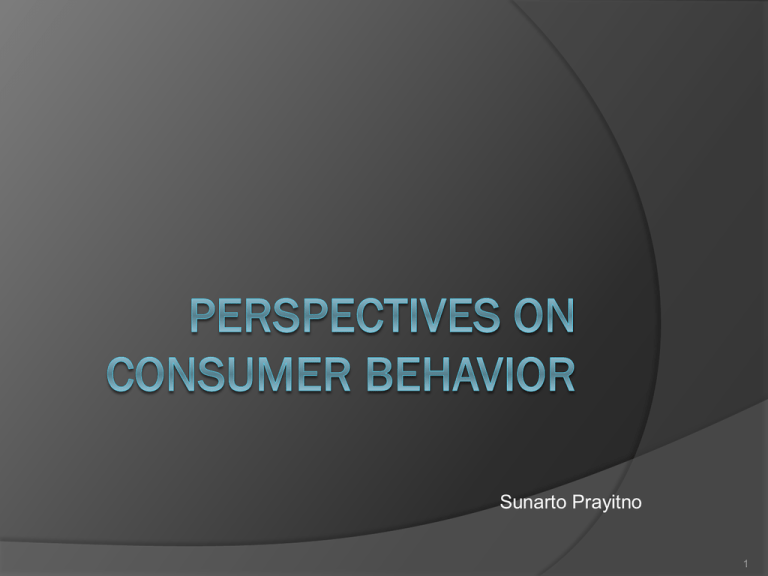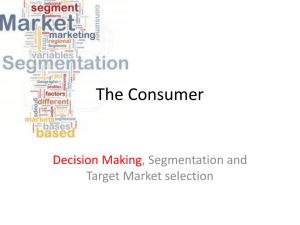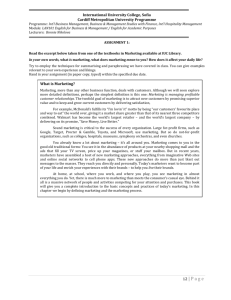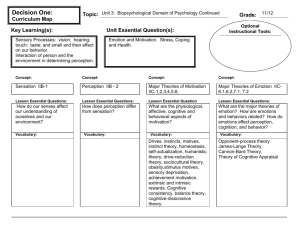Problem Recognition
advertisement

Sunarto Prayitno 1 Introduction Consumer behavior can be defined as the process and activities people engage in when searching for, selecting, purchasing, using, evaluating, and disposing of products and services so as to satisfy their needs and desires. 2 Introduction For many products, purchase decisions are the result of a long, detail process that may include an extensive information search, brand comparisons and evaluations, and other activities. Other purchase decisions are more incidental and may result from little more than seeing a product prominently displayed at a discount price in store. 3 Introduction Marketers’ success in influencing purchase behavior depends in large part on how well they understand consumer behavior. Marketers need to understand how customers gather information regarding various alternatives and use this information to select among competing brands. They need to understand how customers make purchase decision. 4 Consumer Decision Making The conceptual model will be used as a framework for analyzing the consumer decision process. 5 Consumer Decision Making The Consumer Decision-Making Process: The consumer’s purchase decision process is generally viewed as consisting of stage through which the buyer passes in purchasing a product. This model shows that decision making involves a number of internal psychological processes. Motivation, perception, attitude formation, integration, and learning are important to promotional planners, since they influence the general decision-making process of the customer. 6 Problem Recognition The first stage in the consumer decisionmaking process is problem recognition, which occurs when the consumer perceives a need and becomes motivated to solve the problem. Problem recognition is caused by a difference between the consumer’s ideal state and actual state. A discrepancy exists between what the consumer wants the situation to be like and what the situation is really like. 7 Problem Recognition Sources of Problem Recognition: The causes of problem recognition may be vary simple or very complex and may result from changes in the consumer’s current and/or desired state. These causes my be influenced by both internal and external factors. 8 Problem Recognition Sources of Problem Recognition: Out of Stock Dissatisfaction New Needs/Wants Related Products/Purchases Marketer-Induced Problem Recognition New Product 9 Sources of Problem Recognition Out of Stock: Problem recognition occurs when consumers use their existing supply of a product and must replenish their stock. The purchase decision is usually simple and routine and is often resolved by choosing a familiar brand or one to which the consumer feels loyal. Dissatisfaction: Problem recognition is created by the consumer’s dissatisfaction with the current state of affairs and/or the product being used. 10 Sources of Problem Recognition New Needs/Wants: Changes in consumers’ lives often result in new needs and wants. Not all product purchases are based on needs. Some products sought by consumers are not essential but are nonetheless desired. A want has been defined as a felt need that is shaped by a person’s knowledge, culture, and personality. 11 Sources of Problem Recognition Related Products/Purchases: Problem recognition can also stimulated by the purchase of a product. For example, the purchase of new camera, may led to the recognition of a need of accessories, such as additional lenses or a carrying case. 12 Sources of Problem Recognition Marketer-Induced Problem Recognition: Another source of problem recognition is marketer’s action that encourage consumers not to be content with their current state of situation. Ads for personal hygiene products such as mouthwash, deodorant, and foot sprays may be designed to create insecurities that consumer can resolve through the use of these products. New Products: Problem recognition can also occur when innovative products are introduced and brought to the attention of consumers. 13 Examining Consumer Motivations Marketers recognize that while problem recognition is often a basic, simple process, the way a consumer perceives a problem and becomes motivated to solve it will influence the reminder of decision process. Motives – that is, those factors that compel a consumer to take a particular action. 14 Examining Consumer Motivations Hierarchy of Needs: One of the most popular approaches to understanding consumer motivations is based on the classic theory of human motivation popularized many years ago by psychologist Abraham Maslow. His hierarchy of needs theory postulate five basic levels of human needs, arranged in a hierarchy based on their importance. 15 Examining Consumer Motivations 16 Examining Consumer Motivations The five needs are: Psychological Safety Social/Love and Belonging Esteem Self-Actualization 17 Examining Consumer Motivations Psychological - the basic level of primary needs for thing required to sustain life, such as food, shelter, clothing, and sex. Safety – the need for security and safety from physical harm. Social/Love and Belonging – the desire to have satisfying relationships with others and feel a sense of love, affection, belonging, and acceptance. Esteem – the need to feel a sense of accomplishment and gain recognition, status, and respect from others. Self-Actualization – the need for self-fulfillment and a desire to realize one’s own potential. 18 Examining Consumer Motivations According to Maslow’s theory, the lower-level psychological and safety needs must be satisfied before the higher-order needs become meaningful. Once these basic need are satisfied, the individual moves on to attempting to satisfy higher-order needs such as self-esteem. In reality, it is unlikely that people move through the need hierarchy in a stair-step manner. 19 Examining Consumer Motivations Psychoanalytic Theory: A somewhat more controversial approaches to the study of consumer motives is the psychoanalytic theory pioneered by Sigmund Freud. Although his work dealt with the structure and development of personality, Freud also studied the underlying motivations for human behavior. Psychoanalytic theory had a strong influence on the development of modern psychology and on explanations of motivation and personality. 20 Examining Consumer Motivations It has also been applied to the study of consumer behavior by marketers interested in probing deeply rooted motives that may underlie purchase decision. Those who attempt to relate psychoanalytic theory to consumer behavior believe consumers’ motivations for purchasing are often very complex and unclear to the casual observer – and to the consumers themselves. Many motives for purchase and/or consumption may be driven by deep motives one can determine only by probing the subconscious. 21 Information Search The second in the consumer decision-making process is information search. Once consumers perceived a problem or need that can be satisfied by the purchase of a product, they begin to search for information needed to make a purchase decision. The initial search effort often consists of an attempt to scan information stored in memory to recall past experiences and/or knowledge regarding various purchase alternatives. This information retrieval is referred to as internal search. 22 Information Search For many routine, repetitive purchases, previously acquired information that is stored in memory is sufficient for comparing alternatives and making a choice. If the internal search does not yield enough information, the consumer will seek additional information by engaging in external search. External sources of information include: personal sources, marketer-controlled (commercial) sources, and personal experience. 23 Perception Knowledge of how consumers acquire and use information from external sources is important to marketers in formulating communication strategies. Marketers are particularly interested in: (1) how consumers sense external information, (2) how they select and attend to various sources of information, and (3) how this information is interpreted and given meaning. These processes are all part of perception, the process by which an individual receives, selects, organizes, and interprets information to create a meaningful picture of the world. 24 Perception Perception is an individual process; it depends on internal factors such as a person’s beliefs, experiences, needs, moods, and expectations. The perceptual process is also influenced by the characteristics of a stimulus and the context in which it is seen or heard. The process of perception includes: sensation, selecting information, interpreting the information, selective perception, and subliminal perception. 25 Perception Sensation: Perception involved three distinct processes. Sensation is the immediate, direct response of the senses (taste, smell, sight, tough, and hearing) to a stimulus such as an ad, package, brand name, or point-of-purchase display. Perception uses these senses to create a representation of the stimulus. Marketers recognize that it is important to understand consumers’ psychological reactions to marketing stimuli. 26 Perception Selecting Information: Sensory input are important but are only one part of the perceptual process. Other determinants of whether marketing stimuli will be attended to and how they will be interpreted include internal psychological factors such as the consumers’ personality, needs, motives, expectations, and experiences. These psychological inputs explain why people focus on elements of the environment that are relevant to his or her needs and tune out irrelevant stimuli. 27 Perception Interpreting the Information: Once a consumer selects and attends to a stimulus, the perceptual process focuses on organizing, categorizing, and interpreting the incoming information. This stage of the perceptual process is very individualized and is influenced by internal psychological factors. The interpretation and meaning an individual assigns to an incoming stimulus also depend in part of the nature of the stimulus. 28 Perception Selective Perception: Selective exposure occurs as consumers choose whether or not to make themselves available to information. For example, a viewer of a television show may change channels or leave the room during commercial breaks. Selective attention occurs when the consumer chooses to focus attention on certain stimuli while excluding others. 29 Perception The final screening process is selective retention, which means consumers do not remember all the information they see, hear, or read even after attending to and comprehending it. Advertisers attempt to make sure information will be retained in the consumer’s memory so that it will be available when it is time to make a purchase. Mnemonics such as symbols, rhymes, associations, and images that assist in the learning and memory process are helpful. 30 Perception Subliminal Perception: Advertisers know consumers use selective perception to filter out irrelevant or unwanted advertising messages, so they employ various creative tactics to get their messages noticed. One controversial tactic advertisers have been accused of using is appealing to consumers’ subconscious. Subliminal perception refers to the ability to perceive a stimulus that is below the level of conscious awareness. 31 Alternative Evaluation After acquiring information during the information search stage of the decision process, the consumer moves to alternative evaluation. In this stage, the consumer compares the various brands or products he or she has identified as being capable of solving the consumption problem and satisfying the needs or motives that initiated the decision process. The various brands identified as purchase options to be considered during the alternative evaluation process are referred to as the consumer’s evoked set. 32 Alternative Evaluation The Evoked Set: The evoked set is generally only a subset of all the brands of which the consumer is aware. The consumer reduces the number of brands to be reviewed during the alternative evaluation stage to a manageable level. The exact size of the evoked set varies from one consumer to another and depends on such factors as the importance of the purchase and the amount of time and energy the consumer wants to spend comparing alternatives. 33 Alternative Evaluation Evaluative Criteria and Consequences: Once consumers have identified an evoked set and have a list of alternatives, they must evaluate the various brands. This involves comparing the choice alternatives or specific criteria important to the consumer. Evaluative criteria are the dimensions or attributes of a product that are used to compare different alternatives. Evaluative criteria can be objective or subjective. 34 Attitudes Attitudes are one of the most heavily studied concepts in consumer behavior. According to Gordon Allport’s classic definition, “attitudes are learned predispositions to respond to an object.” More recent perspectives view attitudes as a summary construct that represents an individual’s overall feelings toward or evaluation of an object. Consumers hold attitudes toward a variety of objects that are important to marketers, including individuals, brands, companies, product categories, retail stores, or even advertisements. 35 Attitudes Attitudes are important to marketers because they theoretically summarize a consumer’s evaluation of an object, and represent positive or negative feelings and behavioral tendencies. Marketers’ keen interest in attitudes is based on the assumption that they are related to consumers’ purchase behavior. Considerable evidence supports the basic assumption of a relationship between attitudes and behavior. The attitude-behavior link does not always hold; many other factors can affect behavior. 36 Purchase Decision At some point in the buying process, the consumers must stop searching for and evaluating information about alternative brands in the evoked set and make purchase decision. As an outcome of the alternative evaluation stage, the consumers may develop a purchase intention or predisposition to buy certain brand. Purchase intentions are generally based on a matching of purchase motives with attributes or characteristics of brands under consideration. 37 Purchase Decision Their formation involves of many of the personal sub-processes including motivation, perception, attitude formation, and integration. A purchase decision is not the same as an actual purchase. Once a consumer chooses which brand to buy, he or she must still implement the decision and make the actual purchase. Additional decisions may be needed, such as when to buy, where to buy, and how much money to spend. 38 Purchase Decision Often, there is a time delay between the formation of a purchase intention or decision and the actual purchase, particularly for highly involved and complex purchases such as automobiles, personal computers, and consumer durables. 39 Post-Purchase Evaluation The consumer decision process does not end with the purchase. After using the product, the consumer compares the level of performance with expectations and is either satisfied or dissatisfied. Satisfaction occurs when the consumer’s expectations are either met or exceeded; dissatisfaction results when performance is below expectations. 40 Post-Purchase Evaluation The post-purchase evaluation process is important because the feedback acquired from actual use of a product will influence the likelihood of future purchases. Positive performance means the brand is retained in the evoked set and increases the likelihood it will be purchase again. Unfavorable outcomes may lead the consumer to form negative attitudes toward the brand, lessening the likelihood it will be purchased again or even eliminating it from the consumer’s evoked set. 41








